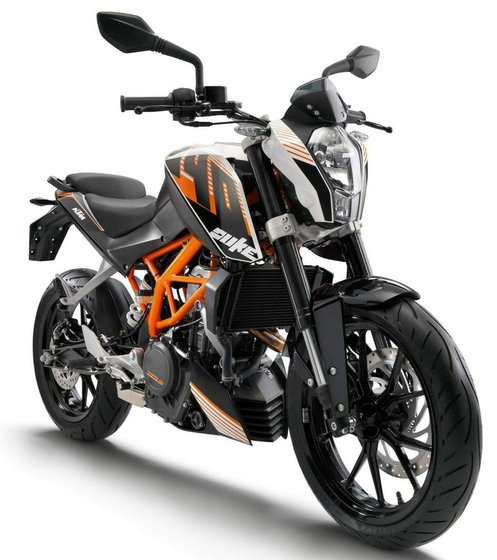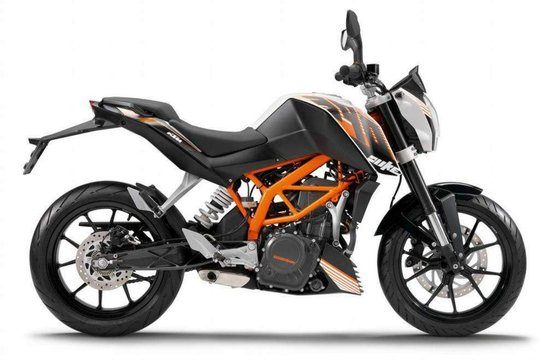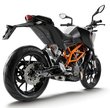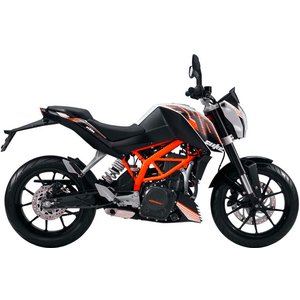KTM 390 Duke [2013–2016]: A Lightweight Revolution That Still Thrills

Overview
When KTM unleashed the 390 Duke in 2013, it wasn’t just another entry into the lightweight motorcycle segment—it was a declaration of war. With its razor-sharp design, punchy single-cylinder engine, and a chassis that seemed to laugh at the laws of physics, the 390 Duke redefined what a small-capacity naked bike could be. Even by today’s standards, this Austrian-Indian collaboration remains a benchmark for agility, affordability, and sheer riding fun. Let’s dive into why this pocket rocket still deserves your attention.
The Heartbeat: Engine & Performance
A Single-Cylinder Symphony
At the core of the 390 Duke lies a liquid-cooled, 373cc single-cylinder engine that punches far above its weight class. Producing 44 hp (32 kW) at 9,500 rpm and 35 Nm (26 ft-lb) of torque at 7,000 rpm, this isn’t your grandfather’s thumper. The DOHC setup, four valves, and Bosch fuel injection ensure a surprisingly refined power delivery.
On the Road:
Twist the throttle, and the Duke surges forward with an eagerness that borders on impatience. Below 4,000 rpm, it’s docile enough for city traffic, but crack it open past 6,000 rpm, and the engine transforms into a snarling beast. The six-speed gearbox is slick, with ratios perfectly spaced to keep the revs in the sweet spot. Highway cruising at 100 km/h (62 mph) feels relaxed at 5,000 rpm, though vibrations start to creep in above 120 km/h (75 mph).
The real magic happens in the twisties. The short-stroke design (89 mm bore × 60 mm stroke) rewards aggressive riding, letting you tap into that 12.8:1 compression ratio for instant bursts of acceleration. It’s not just fast for a 373cc bike—it’s fast, period.
Chassis & Handling: Where Physics Take a Backseat
Featherweight Agility
With a dry weight of 139 kg (306 lbs), the 390 Duke feels like a bicycle with a jet engine. The steel trellis frame and cast aluminum swingarm form a rigid yet forgiving foundation, while the WP suspension—43 mm inverted forks up front and a preload-adjustable monoshock at the rear—delivers 150 mm (5.9 inches) of travel at both ends.
Riding Impressions:
Flicking the Duke through corners is effortless. The Metzeler Sportec M5 tires (110/70-17 front, 150/60-17 rear) offer tenacious grip, and the steering geometry (65° head angle, 100 mm trail) strikes a perfect balance between stability and quick turn-in. Ground clearance is generous at 172 mm (6.8 inches), though the pegs will scrape if you’re pushing hard enough to make a MotoGP rider blush.
Braking duties are handled by a 300 mm front disc with a radial-mount Brembo four-piston caliper and a 230 mm rear disc. The Bosch ABS (disengageable) is flawless, providing confidence in wet conditions without intruding on spirited riding.
Design & Ergonomics: Form Follows Function
Naked Aggression
The 390 Duke’s design is pure KTM: angular, minimalist, and dripping with attitude. The orange-painted trellis frame contrasts starkly against the black or white bodywork, while the stubby tail section and aggressive LED headlight (a rarity in this segment at the time) scream performance.
Comfort & Practicality:
At 800 mm (31.5 inches), the seat height is accessible for shorter riders, though taller riders (over 6 feet) might find the knee angle cramped during long rides. The narrow tank shroud and upright handlebars create a natural riding position—ideal for urban commutes and weekend blasts alike. Wind protection is nonexistent, but that’s part of the naked bike charm.
The 11-liter (2.9-gallon) fuel tank promises up to 200 km (124 miles) per fill, assuming you’re not constantly chasing the redline.
Competition: How the Duke Stacks Up
Kawasaki Ninja 300
The Ninja 300’s parallel-twin engine is smoother and more refined, but its 39 hp (29 kW) can’t match the Duke’s raw excitement. The Ninja’s faired design offers better wind protection for touring, but it’s heavier (172 kg / 379 lbs) and less flickable in tight corners.
Honda CBR500R
Honda’s 471cc twin delivers linear power and superior comfort for two-up riding. However, the CBR500R weighs 195 kg (430 lbs)—a staggering 56 kg (123 lbs) more than the Duke—and lacks the KTM’s playful character.
Yamaha MT-03 (320cc)
Yamaha’s MT-03 (with its 321cc twin) focuses on low-end torque, making it a better city companion. But its softer suspension and less precise handling leave it trailing behind the Duke on backroads.
Verdict:
The 390 Duke dominates for riders prioritizing weight savings, cornering agility, and a visceral riding experience. It’s the motorcycle equivalent of a caffeinated squirrel—small, hyperactive, and impossibly fun.
Maintenance: Keeping the Duke Alive
Key Considerations
- Valve Adjustments:
- Intake: 0.08–0.12 mm (0.003–0.005 in)
-
Exhaust: 0.13–0.17 mm (0.005–0.007 in)
Check every 10,000 km (6,200 miles). Ignoring this can lead to power loss and rough idling. -
Oil Changes:
Use 1.6L of JASO T903 MA-certified 15W-50 oil (with filter). Synthetic oils like Motul 7100 prolong engine life, especially under hard riding. -
Chain Care:
The 5/8 x 1/4" O-ring chain requires regular cleaning and lubrication. Upgrade to a DID Gold chain for durability. -
Brake Fluid & Coolant:
Replace brake fluid (DOT 5.1) every two years. Coolant changes (1.1L) are due annually in hot climates. -
Tire Pressure:
Front: 2.0 bar (29 psi)
Rear: 2.2 bar (32 psi) when riding two-up.
MOTOPARTS.store Recommendations
- Performance Spark Plugs: Swap the stock NGK LKAR8A-9 for iridium variants for smoother throttle response.
- Upgraded Sprockets: A lightweight aluminum rear sprocket reduces rotational mass for quicker acceleration.
- Adjustable Levers: Improve ergonomics with CNC-machined levers for precise control.
- Slip-On Exhaust: Unleash the Duke’s growl with a Euro 4-compliant aftermarket exhaust.
Final Thoughts
The KTM 390 Duke [2013–2016] isn’t just a motorcycle—it’s a masterclass in lightweight engineering. It thrills with its razor-sharp handling, humbles heavier bikes in the corners, and still feels modern a decade later. Whether you’re a new rider seeking a forgiving first bike or a seasoned veteran craving a backroad scalpel, the Duke delivers. And when it’s time to tweak, tune, or personalize, MOTOPARTS.store has everything to keep your orange menace in peak condition.

Agility, adrenaline, and Austrian attitude—the 390 Duke in its natural habitat.

Specifications sheet
| Engine | |
|---|---|
| Stroke: | Four-stroke |
| Max power: | 32 kW | 43.0 hp |
| Max torque: | 35 Nm |
| Fuel system: | Bosch electronically controlled injection (46 mm throttle body) |
| Lubrication: | Forced oil lubrication with 2 Eaton pumps |
| Max power @: | 9500 rpm |
| Displacement: | 373 ccm |
| Max torque @: | 7000 rpm |
| Configuration: | Single |
| Cooling system: | Liquid Cooled |
| Compression ratio: | 12.8:1 |
| Number of cylinders: | 1 |
| Dimensions | |
|---|---|
| Wheelbase: | 1367 mm (53.8 in) |
| Dry weight: | 139 |
| Wet weight: | 149 |
| Seat height: | 800 mm (31.5 in) |
| Ground clearance: | 172 mm (6.8 in) |
| Fuel tank capacity: | 11 L (2.9 US gal) |
| Reserve fuel capacity: | 1.5 L (0.4 US gal) |
| Drivetrain | |
|---|---|
| Chain type: | 5/8 x 1/4" X-Ring |
| Final drive: | chain |
| Gear ratios: | 1st 12:32, 2nd 14:26, 3rd 19:27, 4th 21:24, 5th 23:22, 6th 25:21 |
| Transmission: | 6-speed, claw shifted |
| Rear sprocket: | 45 |
| Front sprocket: | 15 |
| Final drive ratio: | 15:45 |
| Primary drive ratio: | 30:80 |
| Maintenance | |
|---|---|
| Rear tire: | 150/60-17 |
| Engine oil: | SAE 15W-50 |
| Front tire: | 110/70-17 |
| Brake fluid: | DOT 5.1 |
| Spark plugs: | Bosch VR 5 NE or NGK LKAR8A-9 |
| Spark plug gap: | 0.8 |
| Coolant capacity: | 1.1 |
| Forks oil capacity: | 0.9 |
| Engine oil capacity: | 1.6 |
| Engine oil change interval: | Every 5000 km or 2 years |
| Valve clearance (intake, cold): | 0.08–0.12 mm |
| Valve clearance check interval: | 24,000 km / 15,000 mi |
| Valve clearance (exhaust, cold): | 0.13–0.17 mm |
| Recommended tire pressure (rear): | 2.0 bar (29 psi) solo, 2.2 bar (32 psi) with passenger |
| Recommended tire pressure (front): | 2.0 bar (29 psi) |
| Additional Features | |
|---|---|
| ABS: | Bosch 9MB two-channel (disengageable) |
| Trail: | 100 mm (3.9 in) |
| Battery: | 12V 8Ah (maintenance-free) |
| Steering head angle: | 65° |
| Chassis and Suspension | |
|---|---|
| Frame: | Steel trellis frame |
| Rear brakes: | Single 230 mm disc, 1-piston floating caliper (ABS) |
| Front brakes: | Single 300 mm disc, 4-piston radial caliper (ABS) |
| Rear suspension: | WP monoshock, adjustable preload |
| Front suspension: | WP inverted fork, 43 mm |
| Rear wheel travel: | 150 mm (5.9 in) |
| Front wheel travel: | 150 mm (5.9 in) |



















